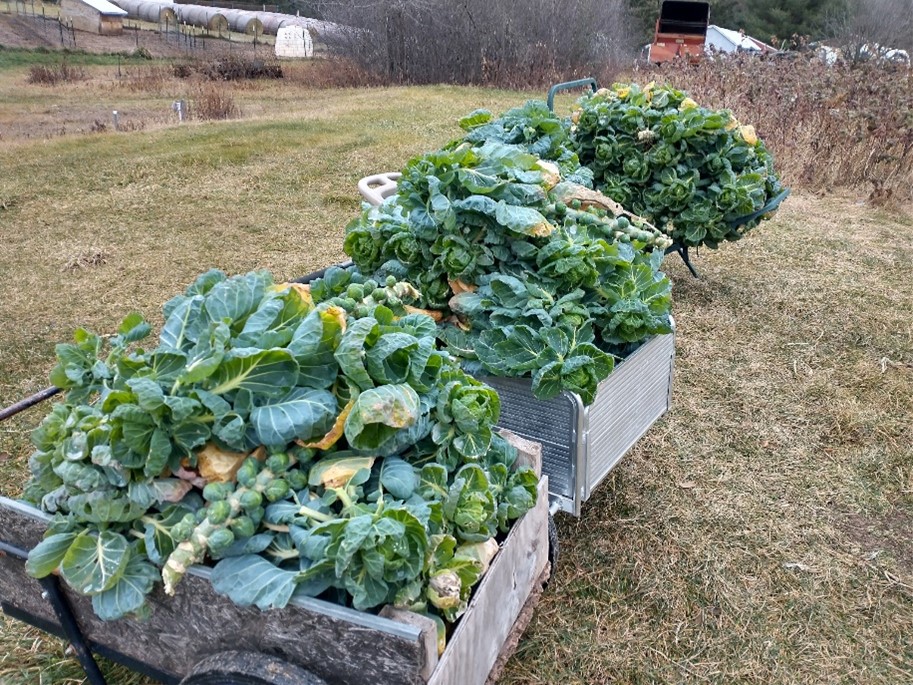Buttoning Up for Winter

In the Northwoods, when autumn lingers into mid-November, you know that winter will arrive not in a gentle slide but like an iron curtain. One day, autumn will be finished, and winter will take center stage. Might as well make some hot chocolate and let it snow!
On the farm, preparations for that iron curtain of the arrival of winter are a long list of tasks. Cleaning out bedding so barns and coops can be fresh for winter, moving animals from mobile summer housing to sturdier and warmer winter housing (some of which must be built before it can be used), harvesting the last of the kole crops and mulching overwintering ones, pulling out temporary Electronet fencing before it’s crushed by ice and snow, storing away firewood, and on and on.
The lingering autumn gave us extra time to work through the list this year, and we used every day of it up until the set of torrentially rainy days kept us inside except for necessary chores. Friday morning, I awoke to notice that the rains had finally subsided, giving the puddles a chance to soak in. As per my usual morning routine, I checked the weather, and saw that 3-6 inches of snow were forecasted for the afternoon. Yikes! Here it comes!
I had a full plate of Zoom fiber arts classes that day, so once I started teaching it would be dark by the time the last session let out. All our Brussels sprout crop was still in the garden, and while I’ve harvested it in snow before, it’s not my favorite. There was likely juuuuuuust enough time for me to chop down the stalks and squirrel them into the garage before the first class, stashing them away before the oncoming snow.
So, I bundled up for the chilly morning and headed out to round up a wheel barrel and the big pruning shears that can handle chopping off the mini tree trunks that are what Brussels sprouts become as they grow. Brussels sprouts are the slowest growing member of the broccoli family. You start them early inside, transplanting them carefully in the garden. After all the other brassicas have come and gone, Brussels sprouts are still plugging away, slowly maturing their little nuggets of yumminess on their tall stalks. They sweeten up after a hard frost, so it’s worth the wait for that too.
We plant our Brussels sprouts on the north side of a bed with cabbages on the south side, allowing them to stack as the cabbage stays low and the Brussels sprouts grow tall but are narrow at their base. It makes an efficient use of space and sunlight, and between the two once mature, they shade out the weeds. Now those towering Brussels sprouts were looking like raggedy frozen soldiers as they awaited the chop chop of my long-handled pruning shears.
Each one was coated in ice from the days of rain that had now frozen. It had pooled up in their rounded leaves and frozen on stems and sprouts. I had to handle each one carefully as the plants felt brittle from being frozen. Normally, when harvesting this crop, I strip the leaves off the stems right there in the garden. This wasn’t going to work this time because of the frozen nature of the plants and the limited time I had for the task, so I began piling the plants into the wheelbarrow whole, creatively stacking them like awkward logs to make the most use of the space.
I had roughly 250 feet of Brussels sprouts to harvest, and my wagon was full in no time. I hauled out the first one and went in search of a second wheelbarrow. I filled that one, then found the old, rounded wheelbarrow we use for hauling fresh wood shavings, and I filled that one. There were still more to go! I had run out of traditional wheelbarrows, but I remembered we had a unique wheeled cart with a fabric sling used to haul firewood. It wasn’t being used at the moment, so I conscripted this as well, which proved to hold the most Brussels sprouts of all—just enough to finish the task. In the end, the harvest was lined up just outside the garden, so I snapped a picture.
Mom came out to join me, and we hauled the carts up to the garage to tuck them into safety just in time for breakfast and launching my morning tapestry class. That afternoon, freezing rain turned to snow, and we finished the day scrambling to mulch carrots, dig the last of the turnips for the pigs from the freezing soil, and catch the last of the snarky laying hens that wouldn’t go to bed in their winter coop to tuck them safely inside.
We were all cold, achy, and exhausted that evening, but we had done it. Aside from a few more odds and ends, the farm was pretty darn well buttoned up for the winter. After a hot meal, it was time for a fire in the wood stove and a chance to relax. Hoping you had a chance to button up for winter too! See you down on the farm sometime.






